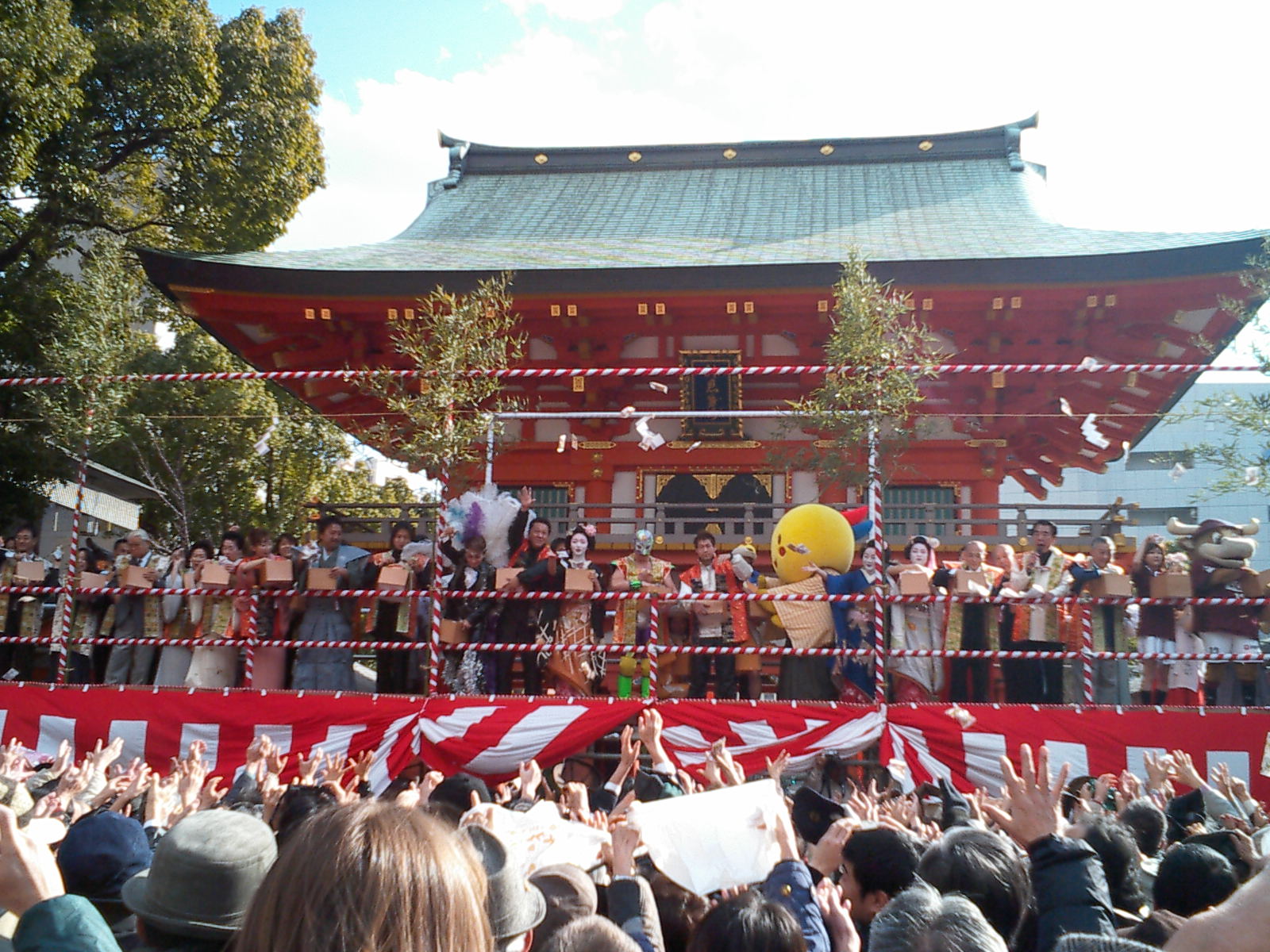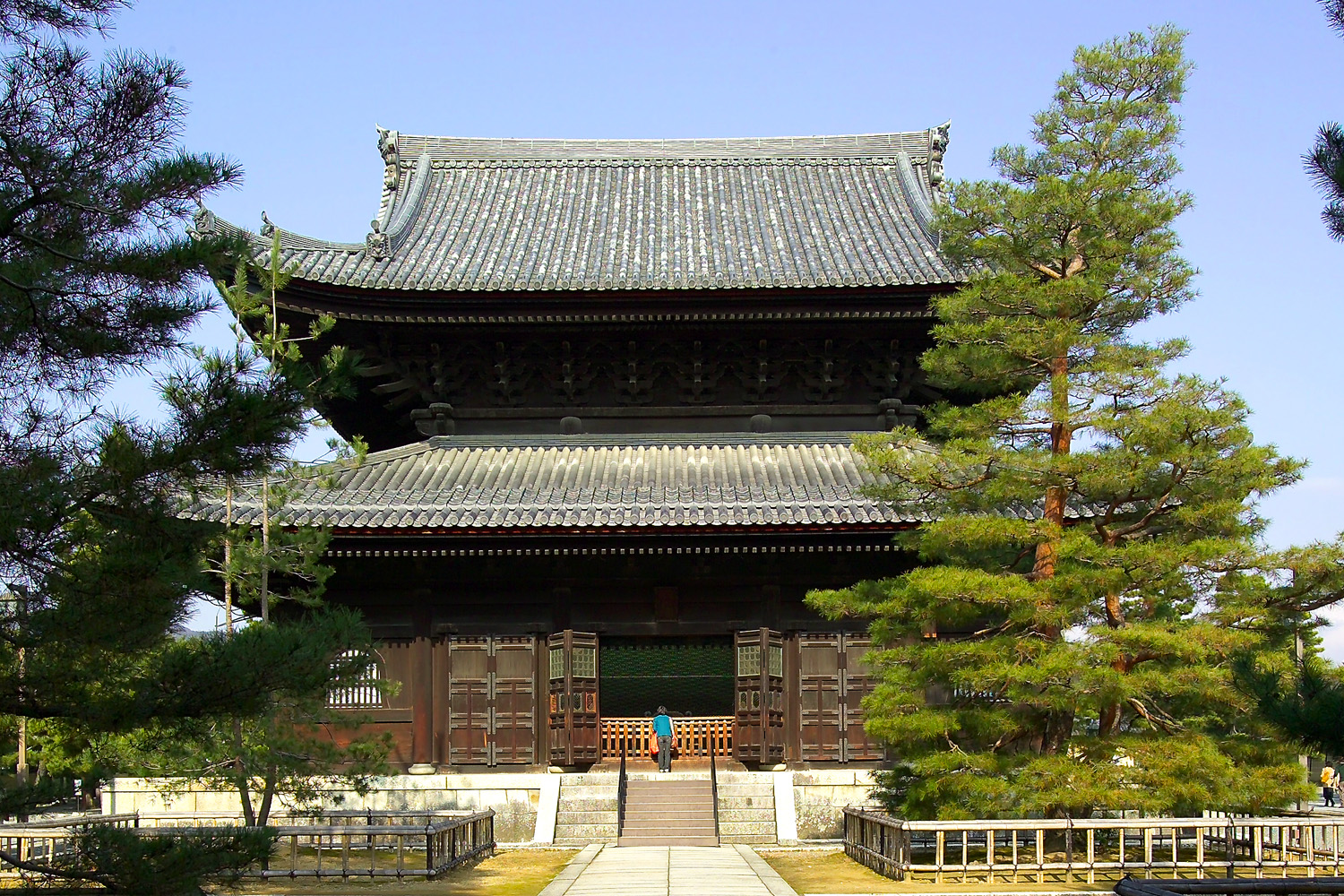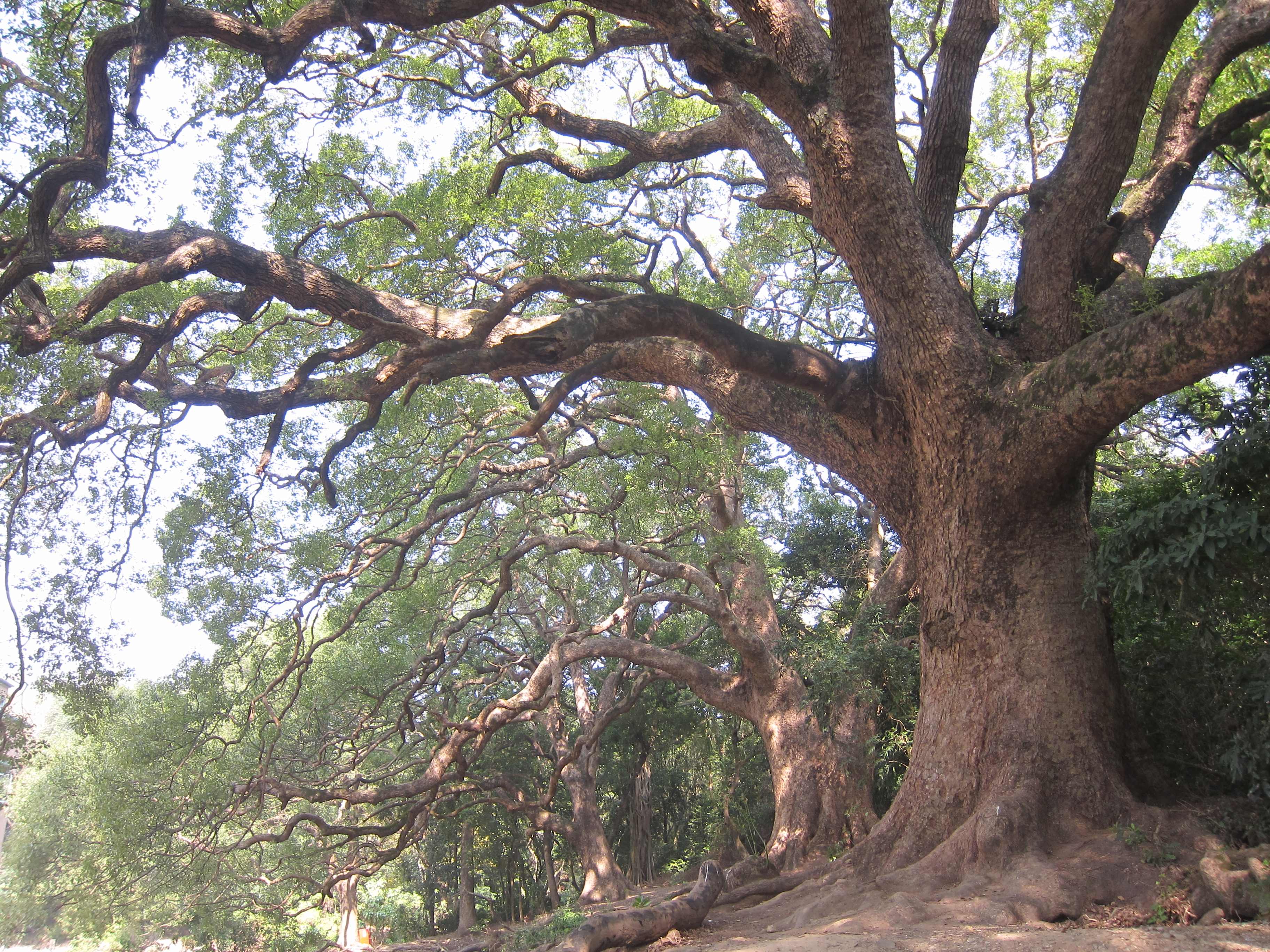|
Kōzō-ji (Kisarazu, Chiba)
is a Buddhist temples in Japan, Buddhist temple located in the city of Kisarazu, Chiba, Kisarazu in Chiba Prefecture, Japan. The temple is also known as the "Takazō Kannon". It is the 30th temple in the Bandō Sanjūsankasho, the circuit of 33 Buddhist temples in Eastern Japan sacred to the Avalokiteśvara, Bodhisattva Guan Yin, Kannon. Amulets issued by the temple are highly valued throughout Japan. History According to legend, Kōzō-ji was founded in the Asuka period during the brief period of the Emperor Yōmei, father of Prince Shōtoku, and a vocal supporter of Buddhism. Later, the priest Gyōki built and dedicated the temple to the Bodhisattava Kannon after having seen the Kannon in a vision. The area around the temple is associated with the mother of Fujiwara no Kamatari (614 – 669), a statesman, courtier and politician of the Nara period. Kamatari's mother despaired of giving birth to a son, but was told in a vision at this temple that she should visit the Kashima ... [...More Info...] [...Related Items...] OR: [Wikipedia] [Google] [Baidu] |
Kisarazu, Chiba
is a Cities of Japan, city located in Chiba Prefecture, Japan. , the city had an estimated population of 136,023 in 63,431 households and a population density of 980 persons per km2. The total area of the city is . Geography Kisarazu is located in the midwestern part of the Bōsō Peninsula, approximately 30 kilometers southwest of the prefectural capital at Chiba (city), Chiba and 70 to 80 kilometers from central Tokyo. The Tokyo Bay Aqua-Line, a bridge-tunnel across Tokyo Bay, connects Kisarazu and the cities of Kawasaki, Kanagawa, Kawasaki and Yokohama, Kanagawa, Yokohama in Kanagawa Prefecture, shortening the road distance to central Tokyo to 30 to 40 kilometers. The city area extends from east to west, and the western part of the city is the flat land of the Kanto Plain, and the eastern part is the plateau of the Kisarazu Plateau and the Boso Hill Range. The Tokyo Bay coastal area is an industrial landfill from the south coast of Kisarazu Port to the direction of Kimitsu ... [...More Info...] [...Related Items...] OR: [Wikipedia] [Google] [Baidu] |
Nara Period
The of the history of Japan covers the years from 710 to 794. Empress Genmei established the capital of Heijō-kyō (present-day Nara). Except for a five-year period (740–745), when the capital was briefly moved again, it remained the capital of Japanese civilization until Emperor Kanmu established a new capital, Nagaoka-kyō, in 784, before moving to Heian-kyō, modern Kyoto, a decade later in 794. Japanese society during this period was predominantly agricultural and centered on village life. Most of the villagers followed Shintō, a religion based on the worship of natural and ancestral spirits named ''kami.'' The capital at Nara was modeled after Chang'an, the capital city of the Tang dynasty. In many other ways, the Japanese upper classes patterned themselves after the Chinese, including adopting the Chinese writing system, Chinese fashion, and a Chinese version of Buddhism. Literature Concentrated efforts by the imperial court to record its history produced the f ... [...More Info...] [...Related Items...] OR: [Wikipedia] [Google] [Baidu] |
Vernal Equinox Day
is a public holiday in Japan that occurs on the date of the Northward equinox in Japan Standard Time (the vernal equinox can occur on different dates in different time-zones), usually March 20 or 21. The date of the holiday is not officially declared until February of the previous year, due to the need for recent astronomical measurements. Vernal Equinox Day became a public holiday in 1948. Prior to that it was the date of , an event relating to Shinto. Like other Japanese holidays, this holiday was repackaged as a non-religious holiday for the sake of separation of religion and state in Japan's postwar constitution. Pre-1945 State Shinto or Kokka Shinto is defined as the Shinto activities surrounding the support of government ideals that the government would have control over. These include day to day worship at public shrines and their messages, traditional ceremony (Kokutai Cult) and rites performed among the Imperial households, and shrines specifically symbolizing the d ... [...More Info...] [...Related Items...] OR: [Wikipedia] [Google] [Baidu] |
Spring (season)
Spring, also known as springtime, is one of the four temperate seasons, succeeding winter and preceding summer. There are various technical definitions of spring, but local usage of the term varies according to local climate, cultures and customs. When it is spring in the Northern Hemisphere, it is autumn in the Southern Hemisphere and vice versa. At the spring equinox, also called the vernal equinox, Daytime (astronomy), days and nights are approximately twelve hours long, with daytime length increasing and nighttime length decreasing as the season progresses until the summer solstice. The spring equinox is in March in the Northern Hemisphere and in September in the Southern Hemisphere, while the summer solstice is in June in the Northern Hemisphere and in December in the Southern Hemisphere. Spring and "springtime" refer to the season, and also to ideas of rebirth, rejuvenation, renewal, resurrection and regrowth. Subtropical and tropical areas have climates better described ... [...More Info...] [...Related Items...] OR: [Wikipedia] [Google] [Baidu] |
Setsubun
is the day before the beginning of spring in the old calendar in Japan. The name literally means 'seasonal division', referring to the day just before the first day of spring in the traditional calendar, known as ; though previously referring to a wider range of possible dates, is now typically held on February 3 (in 2021 and 2025 it was on 2nd February), with the day after – the first day of spring in the old calendar – known as . Both and are celebrated yearly as part of the Spring Festival () in Japan. was accompanied by a number of rituals and traditions held at various levels to drive away the previous year's bad fortunes and evil spirits for the year to come. History has its origins in , a Chinese custom introduced to Japan in the 8th century. It was quite different from the known today. According to the Japanese history book , was first held in Japan in 706, and it was an event to ward off evil spirits held at the court on the last day of the year accord ... [...More Info...] [...Related Items...] OR: [Wikipedia] [Google] [Baidu] |
Shōrō
The two main types of bell tower in Japan The or is the bell tower of a Buddhist temples in Japan, Buddhist temple in Japan, housing the temple's . It can also be found at some Shinto shrines which used to function as temples (see article ''Shinbutsu shūgō''), as for example Nikkō Tōshō-gū. Two main types exist, the older , which has walls, and the more recent or , which does not. History During the Nara period (710–794), immediately after the arrival of Buddhism in Japan bell towers were 3 x 2 Ken (architecture), bay, 2 storied buildings. A typical temple ''garan'' had normally two, one to the left and one to the right of the ''kyōzō'' (or ''kyō-dō''), the sūtra repository. An extant example of this style is Hōryū-ji's Sai-in Shōrō in Nara, Nara, Nara (see photo in the gallery). During the following Heian period (794–1185) was developed a new style called ''hakamagoshi'' which consisted of a two storied, hourglass-shaped building with the bell hanging f ... [...More Info...] [...Related Items...] OR: [Wikipedia] [Google] [Baidu] |
Hondō
Main hall or Main Temple is the building within a Japanese Buddhist monastery compound ('' garan'') which enshrines the main object of veneration.Kōjien Japanese dictionary Because the various denominations deliberately use different terms, this single English term translates several Japanese words, among them ''butsuden'', ''butsu-dō'', ''kondō'', ''konpon-chūdō'', and ''hondō''. ''Hondō'' is its exact Japanese equivalent, while the others are more specialized words used by particular sects or for edifices having a particular structure. Kondō (Asuka and Nara periods) The term started to be used during the Asuka and Nara periods. A ''kondō'' is the centerpiece of an ancient Buddhist temple's ''garan'' in Japan. The origin of the name is uncertain, but it may derive from the perceived preciousness of its content, or from the fact that the interior was lined with gold. This is the name used by the oldest temples in the country.Iwanami Nihonshi Jiten A ''kondō'', for exa ... [...More Info...] [...Related Items...] OR: [Wikipedia] [Google] [Baidu] |
Sanmon
A or is the most important mon of a Japanese Zen Buddhist temple, and is part of the Zen '' shichidō garan'', the group of buildings that forms the heart of a Zen Buddhist temple.JAANUS It can be often found in temples of other denominations too. Most ''sanmon'' are 2- or 3- bay '' nijūmon'' (a type of two-storied gate), but the name by itself does not imply any specific architecture. Position, function and structure Its importance notwithstanding, the ''sanmon'' is not the first gate of the temple, and in fact it usually stands between the '' sōmon'' (outer gate) and the '' butsuden'' (lit. "Hall of Buddha", i.e. the main hall). It used to be connected to a portico-like structure called , which however gradually disappeared during the Muromachi period, being replaced by the , a small building present on both sides of the gate and containing a stairway to the gate's second story. (Both ''sanrō'' are clearly visible in Tōfuku-ji's photo above.) The ''sanmon's'' size ... [...More Info...] [...Related Items...] OR: [Wikipedia] [Google] [Baidu] |
Cinnamomum Camphora
''Camphora officinarum'' is a species of evergreen tree indigenous to warm temperate to subtropical regions of East Asia, including countries such as China, Taiwan, Vietnam, Korea, and Japan. It is known by various names, most notably the camphor tree, camphorwood or camphor laurel. Description ''Camphora officinarum'' grows up to tall. In Japan, where the tree is called ''kusunoki'', five camphor trees are known with a trunk circumference above , with the largest individual, , reaching . The leaves have a glossy, waxy appearance and smell of camphor when crushed. In spring, it produces bright green foliage with masses of very small white fragrant flowers from which its common namesake "smells good tree" in Chinese was given. It produces clusters of black, berry-like fruit around in diameter. Its pale bark is very rough and fissured vertically. Distribution and habitat The species is native to China south of the Yangtze River, Taiwan, southern Japan, Korea, India, an ... [...More Info...] [...Related Items...] OR: [Wikipedia] [Google] [Baidu] |
Gable
A gable is the generally triangular portion of a wall between the edges of intersecting roof pitches. The shape of the gable and how it is detailed depends on the structural system used, which reflects climate, material availability, and aesthetic concerns. The term gable wall or gable end more commonly refers to the entire wall, including the gable and the wall below it. Some types of roof do not have a gable (for example hip roofs do not). One common type of roof with gables, the 'gable roof', is named after its prominent gables. A parapet made of a series of curves (shaped gable, see also Dutch gable) or horizontal steps (crow-stepped gable) may hide the diagonal lines of the roof. Gable ends of more recent buildings are often treated in the same way as the Classic pediment form. But unlike Classical structures, which operate through post and lintel, trabeation, the gable ends of many buildings are actually bearing-wall structures. Gable style is also used in the design of ... [...More Info...] [...Related Items...] OR: [Wikipedia] [Google] [Baidu] |
Hip Roof
A hip roof, hip-roof or hipped roof, is a type of roof where all sides slope downward to the walls, usually with a fairly gentle slope, with variants including Tented roof, tented roofs and others. Thus, a hipped roof has no gables or other vertical sides to the roof. A square hip roof is shaped like a pyramid. Hip roofs on houses may have two triangular sides and two Trapezoid, trapezoidal ones. A hip roof on a rectangular plan has four faces. They are almost always at the same pitch or slope, which makes them symmetrical about the centerlines. Hip roofs often have a consistent level fascia (architecture), fascia, meaning that a gutter can be fitted all around. Hip roofs often have dormer slanted sides. Construction Hip roofs can be constructed on a wide variety of plan shapes. Each ridge is central over the rectangle of the building below it. The triangular faces of the roof are called the hip ends, and they are bounded by the hips themselves. The "hips" and hip rafters ... [...More Info...] [...Related Items...] OR: [Wikipedia] [Google] [Baidu] |
Buddhist Architecture
Buddhist religious architecture developed in the Indian subcontinent. Three types of structures are associated with the sacred architecture, religious architecture of History of Buddhism, early Buddhism: monasteries (viharas), places to venerate relics (stupas), and shrines or prayer halls (chaityas, also called ''chaitya grihas''), which later came to be called temples in some places. The initial function of a stupa was the veneration and safe-guarding of the relics of Gautama Buddha. The earliest archaeologically known example of a stupa is the Relic Stupa of Vaishali located in Bihar, India. In accordance with changes in religious practice, stupas were gradually incorporated into chaitya-grihas (prayer halls). These are exemplified by the complexes of the Ajanta Caves and the Ellora Caves. The Mahabodhi Temple at Bodh Gaya in Bihar, Bihar, India is another well-known example. It is argued that stylistic aspects seen on Buddhist architecture like the stupa may have been influen ... [...More Info...] [...Related Items...] OR: [Wikipedia] [Google] [Baidu] |






